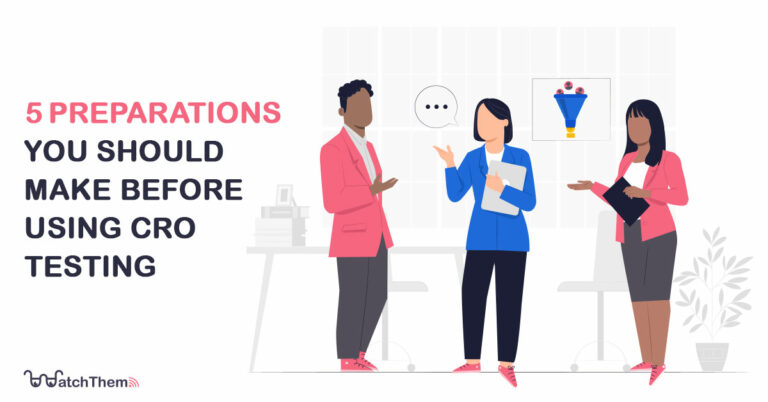Page Contents
You’re so lucky if your company has an experimental culture that believes in change. With each experiment, your optimization efforts allow you to explore new boundaries, which can help you nail your conversion rate optimization game. However, you need some preparation before every change, and CRO testing is no exception.
CRO cannot be defined in a single dimension. For example, there are a variety of ways to optimize your landing page. However, no single experiment can guarantee rapid results (though testing every new practice is a terrific habit to develop!).
In this post, we’ve provided a few popular and not-so-common techniques to help you win at optimization and be prepared for your CRO testing. Keep in mind that your primary goal should be to make these best practices a permanent part of your plan, and you should aim to maximize every impression, click, and visitor.
Note: One way to gather information for creating your CRO testing plan is using analytics software like WatchThemLive. Keep reading to learn more.


What IS CRO Testing?
First things first, let’s see what we mean by CRO testing.
When you make any modifications to your website, a CRO test is a system of determining what the optimum result for your conversion rate is. A/B testing is the most common type of CRO testing, but there are other methods for discovering the optimal conclusion too and they don’t require as much traffic as A/B tests.
For a test to be genuine, it must be backed by data (such as heatmaps, session replay, user feedback, and so on). Otherwise, your tests won’t be accurate and will lead to bad results.
Why Is CRO Testing So Important?
CRO testing is vital because it allows marketers to evaluate the best viable option for increasing conversion rates. This helps companies to save a significant amount of money. Clearly, this money would be lost if they implemented a less successful strategy. And the fact that CRO testing directly impacts revenue and expenses, makes it even more important for any business. So make sure to use it.


Goals to Be Measured While CRO Testing
Any goal, not only hard sales, can be tested to increase conversion rates. Many tests focus on improving conversion rates for sales and transactions. But you can also test to improve smaller actions (known as micro-conversions), such as interactions with elements like filters and search boxes.
While tracking micro-conversions uplifts, keep an eye on the conversion rate for the categories you’re testing to ensure you’re not making changes that may lower your overall sales.
5 Preparations Before Using CRO Testing
After some basic explanations, it’s time for the real work. Here we will name five necessary preparations before starting your CRO testing process. These items will help your test to be more detailed and promising. Let’s get started:
1. Know Your Visitors Deeply
When you don’t know someone, it’s difficult to persuade them to take actions that lead to a conversion goal. It’s considerably more difficult to delight them. Before creating a CRO plan for your conversion funnel, research your visitors’ interests and activities on your site to better understand who they are.
You can use visitor tracking tools that are in the market. For this case, we offer you WatchThemLive.
WatchThemLive is a behavior analytics tool that offers a FREE package with more features than any other paid plan. From website monitoring tools to additional valuable services like session replay and heat mapping, we’ll take care of everything for you.
Our Session Replay service, which has a fantastic UI and a straightforward UX design, will allow you to monitor your visitors’ behavior. As a result, you can make informed judgments and drastically increase your conversion rate.
To use our free package you just need to sign up here.
2. Measure Micro-Conversions
There is a conversion goal for each step in your conversion funnel. Conversions can be seen as a spectrum. The key goals that directly affect your business’s net profit are on the right side of the spectrum. While intermediate metrics such as the number of sign-ups your CTA button created are on the left side. You should consider that you need a balance between them. Otherwise, the spectrum will fall on one side.
At every point of your conversion funnel, these smaller goals, also known as micro-conversions, help our main conversion goal. As a result, measuring them is a smart idea.
If your website does not receive a great amount of traffic, consider these micro-conversions for your future tests because they can be measured rapidly.
3. Your Design Is Your DNA
Always strive to improve the basic functions of your product.
Similarly, the functionality of your product should be explained on your website. This should become your whole brand DNA.
Aesthetics are not a replacement for research and testing. As a result, concentrate on the functioning of your product/services and maximize the features that speak to your core.
What if your landing page already has high traffic? Can you make it any better? Of course. Just Make sure your designs are consistent with your brand, easy to understand for your audience, and simple to change.
4. Documenting Prevents Recreating Mistakes
Make sure you write down all you learned from your CRO testing. These lessons can include things like how to set up the test (so you don’t make the same mistakes twice), hypotheses, and observations. In addition, it includes targeting, the QA process, the test metrics, and so on.
Try to expand on your findings, from improving your testing skills to incorporating the winning strategies.
5. Never Underestimate CRO Mapping
Random testing most likely will not give you any good results. They can hurt you. Imagine trying to test your CRO without any roadmap. You wind up testing every single page every time if you don’t have a proper roadmap in place, and you end up with inconclusive results.
These results don’t provide a clear picture of your visitors’ behavior, and they don’t help with conversions.
For your experimentation efforts to deliver productive results, you need a map to follow. Make sure to prepare it before starting any CRO testing.
- Start with the more bold, impactful, and targeted experiments. Therefore, you will acquire the best results in the quickest amount of time.
- Prioritize simple-to-implement tests with a large financial impact.
Keep reading to learn more about CRO roadmap.


What Is a CRO Roadmap?
A CRO roadmap is like a calendar that contains a detailed schedule of the subject of your test, the resources it requires, the time at which the test is going to be launched, and the expected result.
The CRO roadmap is basically a CRO testing plan. It plans each stage and its requirements and makes you ready for the next step. Without a CRO roadmap, you will be lost and on top of that, since the results are concluded from a poorly planned experiment, they won’t be accurate. However, a CRO roadmap ensures the certainty of your results.
How to Build a CRO Roadmap?
As you may know, building a CRO roadmap will help you increase your conversion rate, however, you should know what you need to do in order to create one. Read the steps below to learn how.
1. Determine Your Business Goals
First, clarify your business goals. What long-term business goals do you have in mind? For example, this goal is increasing sales conversion rate for an eCommerce business, and for a SaaS company, it’s increasing customer lifetime value (CLV).
The important thing here is that most of these business goals are related to an important metric and should be measurable.
2. List Your Metrics and Strategies Corresponding to Your Business Goals
Now let’s get into more details. After you have determined your business goals, you should think about the strategies you can use to meet them.
For example, if your eCommerce business goal is to increase sales conversion rate, you might get there by:
- Personalizing your website
- Improving customer experience
- Using SMS alerts
Do this for all of your goals, so you have a general idea of what you should be doing to reach those goals.
The metrics you can measure here are:
- Total revenue
- Average revenue per customer
- Percentage of revenue from new vs. existing customers
- Win rate
There are other metrics you can measure based on your situation.
3. Determine Your Current State and Establish a Baseline
Before you can start coming up with strategies to meet your business goals, you need a baseline to start your optimization plan from. This starting point is a CRO audit. Your CRO audit should be telling you the key metrics you need to measure, backed up with data.
4. Create Test Hypotheses
Use the data you gathered in the previous step and use it to form a hypothesis. For example, if the number of your abandoned carts has increased recently, it might be because of a complex checkout process.
So, your hypothesis here should be, “simplifying the checkout process.” Your hypothesis and suggestion for fixing the problem should be direct and single-element focused. Sometimes, you may just need to change an element of a page, not the whole page.
5. Prioritize Your Hypotheses
The last step is to prioritize your hypotheses to help you understand which one needs immediate action. You can prioritize your hypotheses in two ways:
- Results-first: Using this approach, you can prioritize your CRO experiments based on the expected results.
- Resource-first: Using this approach, you can prioritize your tests based on the resources you already have. For example, if you already have an SEO expert, you may want to start with updating your keywords to get a higher placement on search engines.
In the end, bring the information from all these steps together and create your CRO roadmap.
Conclusion
Experiments might be highly unpredictable at first. Indeed, the process of CRO testing is just like a marathon, not a sprint. You need to get prepared well before the match.
Then, stay on track for further tests. Therefore, we hope that the preparations discussed in this blog post will have a gradual and purposeful affect on boosting your business.
If you want to immediately start your CRO testing plan, you can use an analytics tool like WatchThemLive. Sign up for FREE and see what’s next!

